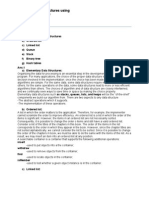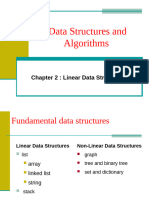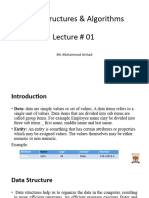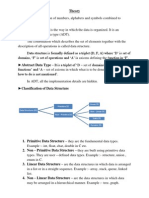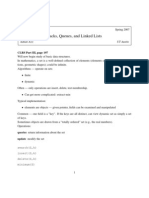Elementary Data Structures: Steven Skiena
Elementary Data Structures: Steven Skiena
Uploaded by
satyabashaCopyright:
Available Formats
Elementary Data Structures: Steven Skiena
Elementary Data Structures: Steven Skiena
Uploaded by
satyabashaOriginal Title
Copyright
Available Formats
Share this document
Did you find this document useful?
Is this content inappropriate?
Copyright:
Available Formats
Elementary Data Structures: Steven Skiena
Elementary Data Structures: Steven Skiena
Uploaded by
satyabashaCopyright:
Available Formats
Lecture 4:
Elementary Data Structures
Steven Skiena
Department of Computer Science
State University of New York
Stony Brook, NY 117944400
http://www.cs.sunysb.edu/skiena
Problem of the Day
True or False?
1. 2n
2
+ 1 = O(n
2
)
2.
n = O(log n)
3. log n = O(
n)
4. n
2
(1 +
n) = O(n
2
log n)
5. 3n
2
+
n = O(n
2
)
6.
nlog n = O(n)
7. log n = O(n
1/2
)
The Base is not Asymptotically Important
Recall the denition, c
log
c
x
= x and that
log
b
a =
log
c
a
log
c
b
Thus log
2
n = (1/ log
100
2) log
100
n. Since 1/ log
100
2 =
6.643 is just a constant, it does not matter in the Big Oh.
Federal Sentencing Guidelines
2F1.1. Fraud and Deceit; Forgery; Offenses Involving Altered or Counterfeit Instruments other than Counterfeit Bearer Obligations of the United States.
(a) Base offense Level: 6
(b) Specic offense Characteristics
(1) If the loss exceeded $2,000, increase the offense level as follows:
Loss(Apply the Greatest) Increase in Level
(A) $2,000 or less no increase
(B) More than $2,000 add 1
(C) More than $5,000 add 2
(D) More than $10,000 add 3
(E) More than $20,000 add 4
(F) More than $40,000 add 5
(G) More than $70,000 add 6
(H) More than $120,000 add 7
(I) More than $200,000 add 8
(J) More than $350,000 add 9
(K) More than $500,000 add 10
(L) More than $800,000 add 11
(M) More than $1,500,000 add 12
(N) More than $2,500,000 add 13
(O) More than $5,000,000 add 14
(P) More than $10,000,000 add 15
(Q) More than $20,000,000 add 16
(R) More than $40,000,000 add 17
(Q) More than $80,000,000 add 18
Make the Crime Worth the Time
The increase in punishment level grows logarithmically in the
amount of money stolen.
Thus it pays to commit one big crime rather than many small
crimes totalling the same amount.
Elementary Data Structures
Mankinds progress is measured by the number of things we
can do without thinking.
Elementary data structures such as stacks, queues, lists,
and heaps are the off-the-shelf components we build our
algorithm from.
There are two aspects to any data structure:
The abstract operations which it supports.
The implementation of these operations.
Data Abstraction
That we can describe the behavior of our data structures in
terms of abstract operations is why we can use them without
thinking.
That there are different implementations of the same abstract
operations enables us to optimize performance.
Contiguous vs. Linked Data Structures
Data structures can be neatly classied as either contiguous
or linked depending upon whether they are based on arrays or
pointers:
Contiguously-allocated structures are composed of single
slabs of memory, and include arrays, matrices, heaps, and
hash tables.
Linked data structures are composed of multiple distinct
chunks of memory bound together by pointers, and
include lists, trees, and graph adjacency lists.
Arrays
An array is a structure of xed-size data records such that
each element can be efciently located by its index or
(equivalently) address.
Advantages of contiguously-allocated arrays include:
Constant-time access given the index.
Arrays consist purely of data, so no space is wasted with
links or other formatting information.
Physical continuity (memory locality) between successive
data accesses helps exploit the high-speed cache memory
on modern computer architectures.
Dynamic Arrays
Unfortunately we cannot adjust the size of simple arrays in
the middle of a programs execution.
Compensating by allocating extremely large arrays can waste
a lot of space.
With dynamic arrays we start with an array of size 1, and
double its size from m to 2m each time we run out of space.
How many times will we double for n elements? Only
log
2
n.
How Much Total Work?
The apparent waste in this procedure involves the recopying
of the old contents on each expansion.
If half the elements move once, a quarter of the elements
twice, and so on, the total number of movements M is given
by
M =
lg n
i=1
i n/2
i
= n
lg n
i=1
i/2
i
n
i=1
i/2
i
= 2n
Thus each of the n elements move an average of only twice,
and the total work of managing the dynamic array is the same
O(n) as a simple array.
Pointers and Linked Structures
Pointers represent the address of a location in memory.
A cell-phone number can be thought of as a pointer to its
owner as they move about the planet.
In C,
*
p denotes the item pointed to by p, and &x denotes the
address (i.e. pointer) of a particular variable x.
A special NULL pointer value is used to denote structure-
terminating or unassigned pointers.
Linked List Structures
typedef struct list {
item type item;
struct list
*
next;
} list;
Clinton Jefferson Lincoln NIL
Searching a List
Searching in a linked list can be done iteratively or
recursively.
list
*
search list(list
*
l, item type x)
{
if (l == NULL) return(NULL);
if (l >item == x)
return(l);
else
return( search list(l >next, x) );
}
Insertion into a List
Since we have no need to maintain the list in any particular
order, we might as well insert each new item at the head.
void insert list(list
**
l, item type x)
{
list
*
p;
p = malloc( sizeof(list) );
p >item = x;
p >next =
*
l;
*
l = p;
}
Note the
**
l, since the head element of the list changes.
Deleting from a List
delete list(list
**
l, item type x)
{
list
*
p; (
*
item pointer
*
)
list
*
last = NULL; (
*
predecessor pointer
*
)
p =
*
l;
while (p >item != x) { (
*
find item to delete
*
)
last = p;
p = p >next;
}
if (last == NULL) (
*
splice out of the list
*
)
*
l = p >next;
else
last >next = p >next;
free(p); (
*
return memory used by the node
*
)
}
Advantages of Linked Lists
The relative advantages of linked lists over static arrays
include:
1. Overow on linked structures can never occur unless the
memory is actually full.
2. Insertions and deletions are simpler than for contiguous
(array) lists.
3. With large records, moving pointers is easier and faster
than moving the items themselves.
Dynamic memory allocation provides us with exibility on
how and where we use our limited storage resources.
Stacks and Queues
Sometimes, the order in which we retrieve data is independent
of its content, being only a function of when it arrived.
A stack supports last-in, rst-out operations: push and pop.
A queue supports rst-in, rst-out operations: enqueue and
dequeue.
Lines in banks are based on queues, while food in my
refrigerator is treated as a stack.
Impact on Tree Traversal
Both can be used to store nodes to visit in a tree, but the order
of traversal is completely different.
1
2 3
4 5 6 7
1
5 2
7 6 4 3
Stack Queue
Which order is friendlier for WWW crawler robots?
Dictonary / Dynamic Set Operations
Perhaps the most important class of data structures maintain
a set of items, indexed by keys.
Search(S,k) A query that, given a set S and a key value
k, returns a pointer x to an element in S such that key[x]
= k, or nil if no such element belongs to S.
Insert(S,x) A modifying operation that augments the set
S with the element x.
Delete(S,x) Given a pointer x to an element in the set S,
remove x from S. Observe we are given a pointer to an
element x, not a key value.
Min(S), Max(S) Returns the element of the totally
ordered set S which has the smallest (largest) key.
Next(S,x), Previous(S,x) Given an element x whose key
is from a totally ordered set S, returns the next largest
(smallest) element in S, or NIL if x is the maximum
(minimum) element.
There are a variety of implementations of these dictionary
operations, each of which yield different time bounds for
various operations.
Array Based Sets: Unsorted Arrays
Search(S,k) - sequential search, O(n)
Insert(S,x) - place in rst empty spot, O(1)
Delete(S,x) - copy nth item to the xth spot, O(1)
Min(S,x), Max(S,x) - sequential search, O(n)
Successor(S,x), Predecessor(S,x) - sequential search,
O(n)
Array Based Sets: Sorted Arrays
Search(S,k) - binary search, O(lg n)
Insert(S,x) - search, then move to make space, O(n)
Delete(S,x) - move to ll up the hole, O(n)
Min(S,x), Max(S,x) - rst or last element, O(1)
Successor(S,x), Predecessor(S,x) - Add or subtract 1 from
pointer, O(1)
Pointer Based Implementation
We can maintain a dictionary in either a singly or doubly
linked list.
L
L
A B C D E F
A B C D E F
Doubly Linked Lists
We gain extra exibility on predecessor queries at a cost of
doubling the number of pointers by using doubly-linked lists.
Since the extra big-Oh costs of doubly-linkly lists is zero,
we will usually assume they are, although it might not be
necessary.
Singly linked to doubly-linked list is as a Conga line is to a
Can-Can line.
You might also like
- Microprocessor Project 1Document8 pagesMicroprocessor Project 1himanshuNo ratings yet
- BRFplusDocument35 pagesBRFplusKarim Derouiche0% (1)
- Arrays LinkedList CheatSheetDocument7 pagesArrays LinkedList CheatSheetYashaswini SNo ratings yet
- Lecture 5Document25 pagesLecture 5satyabashaNo ratings yet
- DatastructureDocument49 pagesDatastructuref.t.tasnooNo ratings yet
- Introduction To Data StructuresDocument27 pagesIntroduction To Data StructuresPratibha BahugunaNo ratings yet
- DSA Notes - M.K.GDocument18 pagesDSA Notes - M.K.Gshekhawatharsh54No ratings yet
- CSC202 DataStructureANDAgorithm HODocument31 pagesCSC202 DataStructureANDAgorithm HOemjay2010No ratings yet
- Solutions of DSA (MST - 1 Paper)Document11 pagesSolutions of DSA (MST - 1 Paper)manishhadiabad70No ratings yet
- Data Structures: Steven SkienaDocument25 pagesData Structures: Steven SkienaPusat Tuisyen Bestari IlmuNo ratings yet
- Data Structures and Algorithms: (CS210/ESO207/ESO211)Document21 pagesData Structures and Algorithms: (CS210/ESO207/ESO211)Moazzam HussainNo ratings yet
- M.C.a. (Sem - II) Paper - I - Data StructuresDocument132 pagesM.C.a. (Sem - II) Paper - I - Data Structuresbaluchandrashekar2008No ratings yet
- Data Structures NotesDocument17 pagesData Structures NotesNaveen Reddy100% (1)
- Data StructuresDocument15 pagesData Structuresnishanthchandran782No ratings yet
- Data StructureDocument13 pagesData Structuremeet makwanaNo ratings yet
- Elementary Data StructureDocument9 pagesElementary Data StructurekayisledestaNo ratings yet
- Unit 1 - Lists RB NotesDocument34 pagesUnit 1 - Lists RB Notes110123104026No ratings yet
- Abstract Data Types (Adts) : Applications of Data StructuresDocument16 pagesAbstract Data Types (Adts) : Applications of Data StructuresSuryaNo ratings yet
- Internal Sorting:Definition: When The Entire Dataset Can FitDocument12 pagesInternal Sorting:Definition: When The Entire Dataset Can FitShubham KumarNo ratings yet
- Linked Lists, Arrays, Stacks and QueuesDocument7 pagesLinked Lists, Arrays, Stacks and QueuesdiptanshujainNo ratings yet
- Dsa AnswersDocument22 pagesDsa AnswersanmolNo ratings yet
- CS301 Short Notes MidTerm by Vu Topper RMDocument21 pagesCS301 Short Notes MidTerm by Vu Topper RMSAIM ALI RASHIDNo ratings yet
- DS TheoryDocument7 pagesDS TheorywarikadwaitNo ratings yet
- Mcoo68 Smu Mca Sem2 2011Document23 pagesMcoo68 Smu Mca Sem2 2011Nitin SivachNo ratings yet
- Chapter 2 Linear Data StructuresDocument77 pagesChapter 2 Linear Data Structureschembri022No ratings yet
- DSDocument8 pagesDShassanameer1022No ratings yet
- Data StructureDocument11 pagesData Structureabdulrahmanhamza2205No ratings yet
- BS351_1 data structure notes for qp24Document18 pagesBS351_1 data structure notes for qp24chigurintalsweetyreddyNo ratings yet
- Introduction To Algorithms, Recitation 2Document10 pagesIntroduction To Algorithms, Recitation 2TomNo ratings yet
- UNIT1 Data StructuresDocument15 pagesUNIT1 Data StructuresSumit RajputNo ratings yet
- Chap4-DS-Imp QnAnsDocument9 pagesChap4-DS-Imp QnAnsankushshastryNo ratings yet
- DS ImpDocument2 pagesDS ImpSharfuddin ShariffNo ratings yet
- Data StructuresDocument34 pagesData StructuresJoan VincentNo ratings yet
- Unit 1Document14 pagesUnit 12004pujadasNo ratings yet
- DS 2009-2016Document59 pagesDS 2009-2016uttamNo ratings yet
- data structureDocument19 pagesdata structureshubhamgoswami879No ratings yet
- Sorting CompDocument18 pagesSorting CompTANISHQ KALENo ratings yet
- Cs 301 Data Structures Midterm NotesDocument20 pagesCs 301 Data Structures Midterm Notesumairabbas13239No ratings yet
- Data Structutes Using C'Document7 pagesData Structutes Using C'Sumitavo NagNo ratings yet
- Introduction To Algorithm Complexity: News About Me Links ContactDocument8 pagesIntroduction To Algorithm Complexity: News About Me Links Contactjay_prakash02No ratings yet
- DS Module 1Document22 pagesDS Module 1dwarakadileep05No ratings yet
- CS204-lec01 - Intro, Array, Array ListDocument21 pagesCS204-lec01 - Intro, Array, Array Listanasmajeed2627No ratings yet
- Data Structure & AlgorithmDocument36 pagesData Structure & AlgorithmRubab AnamNo ratings yet
- Lecture05 v08Document33 pagesLecture05 v08Mykhailo ShubinNo ratings yet
- Advance Data Structure ASSIGNMENTDocument13 pagesAdvance Data Structure ASSIGNMENTMudasir KhanNo ratings yet
- A hash table.docxDocument42 pagesA hash table.docxSudhanshu ChandNo ratings yet
- Data Structure - UNIT-1Document28 pagesData Structure - UNIT-1Sriram SekarNo ratings yet
- Worksheet On Data StructureDocument8 pagesWorksheet On Data StructureWiki EthiopiaNo ratings yet
- 22c:31 Algorithms: Ch3: Data StructuresDocument38 pages22c:31 Algorithms: Ch3: Data StructuresBunny Lucky KalyanNo ratings yet
- Unit 1 Introduction of DS Stack QueueDocument11 pagesUnit 1 Introduction of DS Stack QueueTybca077Goyani VaidehiNo ratings yet
- Data Structure FAQDocument3 pagesData Structure FAQAffable kalyaniNo ratings yet
- PdsDocument37 pagesPdsnandhuldkNo ratings yet
- Fundamentals of Data Structure: - Niraj AgarwalDocument176 pagesFundamentals of Data Structure: - Niraj Agarwaljeysam100% (1)
- Data Structures & Algorithms 01Document21 pagesData Structures & Algorithms 01awaisbaryal25No ratings yet
- Primitive DS Linear DSDocument10 pagesPrimitive DS Linear DSProf. Jignesh SohaliyaNo ratings yet
- Datastructure MaterialDocument60 pagesDatastructure MaterialvinodkharNo ratings yet
- Stacks Queues ListsDocument7 pagesStacks Queues ListsAnkush BhaalNo ratings yet
- LINKED LIST STRUCTURE ORGDocument19 pagesLINKED LIST STRUCTURE ORGbrownmichaelevans045No ratings yet
- Stacks, Queues, and Linked Lists: ECE360CDocument7 pagesStacks, Queues, and Linked Lists: ECE360CNirmal MohanNo ratings yet
- Ignou Mcs 031 Solved PaperDocument7 pagesIgnou Mcs 031 Solved PaperGaurav Sood0% (2)
- Lect12 Photodiode DetectorsDocument80 pagesLect12 Photodiode DetectorsVishal KumarNo ratings yet
- CS195-5: Introduction To Machine Learning: Greg ShakhnarovichDocument33 pagesCS195-5: Introduction To Machine Learning: Greg ShakhnarovichsatyabashaNo ratings yet
- Lect1 General BackgroundDocument124 pagesLect1 General BackgroundUgonna OhiriNo ratings yet
- Linear Algebra For Computer Vision - Part 2: CMSC 828 DDocument23 pagesLinear Algebra For Computer Vision - Part 2: CMSC 828 DsatyabashaNo ratings yet
- Lecture 4Document9 pagesLecture 4satyabashaNo ratings yet
- Chem 373 - Lecture 5: Eigenvalue Equations and OperatorsDocument21 pagesChem 373 - Lecture 5: Eigenvalue Equations and OperatorsNuansak3No ratings yet
- 4 Lecture 4 (Notes: J. Pascaleff) : 4.1 Geometry of V VDocument5 pages4 Lecture 4 (Notes: J. Pascaleff) : 4.1 Geometry of V VsatyabashaNo ratings yet
- Lecture 4Document9 pagesLecture 4satyabashaNo ratings yet
- Lecture 3Document18 pagesLecture 3satyabashaNo ratings yet
- Lecture 3Document4 pagesLecture 3satyabashaNo ratings yet
- Topics To Be Covered: - Elements of Step-Growth Polymerization - Branching Network FormationDocument43 pagesTopics To Be Covered: - Elements of Step-Growth Polymerization - Branching Network FormationsatyabashaNo ratings yet
- Image Formation in Man and MachinesDocument45 pagesImage Formation in Man and MachinessatyabashaNo ratings yet
- Image Analysis: Pre-Processing of Affymetrix ArraysDocument14 pagesImage Analysis: Pre-Processing of Affymetrix ArrayssatyabashaNo ratings yet
- Program Analysis: Steven SkienaDocument20 pagesProgram Analysis: Steven SkienasatyabashaNo ratings yet
- Brightness: and CDocument39 pagesBrightness: and CsatyabashaNo ratings yet
- Lecture 2Document3 pagesLecture 2satyabashaNo ratings yet
- Asymptotic Notation: Steven SkienaDocument17 pagesAsymptotic Notation: Steven SkienasatyabashaNo ratings yet
- History British I 20 Wil S GoogDocument709 pagesHistory British I 20 Wil S GoogsatyabashaNo ratings yet
- Genomic Signal Processing: Classification of Disease Subtype Based On Microarray DataDocument26 pagesGenomic Signal Processing: Classification of Disease Subtype Based On Microarray DatasatyabashaNo ratings yet
- Lecture 2Document15 pagesLecture 2satyabashaNo ratings yet
- A Christopher Hitchens Bookshelf-9Document2 pagesA Christopher Hitchens Bookshelf-9satyabashaNo ratings yet
- Ur10 User Manual en GlobalDocument179 pagesUr10 User Manual en GlobalEnterpreneur SetanNo ratings yet
- A Practical Guide To Working With KubernetesDocument20 pagesA Practical Guide To Working With Kubernetesమేదరమెట్ల పట్టాభి రాంNo ratings yet
- SK Product Wrapper.g.dartDocument3 pagesSK Product Wrapper.g.dartİlter Engin KIZILGÜNNo ratings yet
- Changes-9 2 1Document12 pagesChanges-9 2 1Alexander SoNo ratings yet
- Buildroot WorkshopDocument43 pagesBuildroot WorkshopassimilatNo ratings yet
- Knapsack Problem IntroDocument19 pagesKnapsack Problem IntroBruno SaturnNo ratings yet
- 21cs56 - Operating Systems Chapter 6 - (Module2) Process SynchronizationDocument61 pages21cs56 - Operating Systems Chapter 6 - (Module2) Process SynchronizationNishitha RNo ratings yet
- ITS 5001 Course Outline 2018Document5 pagesITS 5001 Course Outline 2018Kushal KanungoNo ratings yet
- BCA3010Document6 pagesBCA3010Mrinal KalitaNo ratings yet
- Decimal Add SubtractDocument3 pagesDecimal Add Subtractapi-370541284No ratings yet
- JDE Cycle Count Test Script!Document10 pagesJDE Cycle Count Test Script!helllwerNo ratings yet
- Aulas Y Horarios: Facultad de Ingeniería Coordinación de Ingeniería en Computación SEMESTRE 2019 BDocument1 pageAulas Y Horarios: Facultad de Ingeniería Coordinación de Ingeniería en Computación SEMESTRE 2019 BIván Martínez AguirreNo ratings yet
- Unit Iii GraphsDocument32 pagesUnit Iii Graphsrno68792No ratings yet
- Performing A Multiobjective Optimization Using The Genetic Algorithm - MATLAB & Simulink Example - MathWorks IndiaDocument5 pagesPerforming A Multiobjective Optimization Using The Genetic Algorithm - MATLAB & Simulink Example - MathWorks IndiaSunil VermaNo ratings yet
- 01 Poongavanam PDFDocument14 pages01 Poongavanam PDFAanand67% (3)
- 1812 748 Analog Devices Roopa Kotekar 25 Jan 19 USD Final N6705CDocument1 page1812 748 Analog Devices Roopa Kotekar 25 Jan 19 USD Final N6705CRajesh PrabhuNo ratings yet
- Mckeen Its2 PP CasesDocument15 pagesMckeen Its2 PP CasesStacey Miller50% (2)
- The Top 10 Entrepreneurs in India: Prepared By:-Deepak GaurDocument12 pagesThe Top 10 Entrepreneurs in India: Prepared By:-Deepak GaurDeepak GaurNo ratings yet
- Project Report Text Editor in JavaDocument10 pagesProject Report Text Editor in JavaKuldeep Sharma100% (1)
- Copy ControlDocument11 pagesCopy ControlAamrnadh100% (1)
- IT2030 - Object Oriented Programming-Version BDocument6 pagesIT2030 - Object Oriented Programming-Version Bit20046798No ratings yet
- Application Modernization DB2 For i5OSDocument50 pagesApplication Modernization DB2 For i5OStwcstk7No ratings yet
- Exam Prep 310Document3 pagesExam Prep 310nerdyall51No ratings yet
- A Micro Project On Dsu1111Document10 pagesA Micro Project On Dsu1111shaikhnumn22No ratings yet
- Iot Syllabus Sem 8 Be EtrxDocument3 pagesIot Syllabus Sem 8 Be EtrxThe Reality Check0% (1)
- OOPS With Java Important Questions For End SemDocument34 pagesOOPS With Java Important Questions For End Semsahil.arora.cs27No ratings yet
- AHA 2940 2940W InstallDocument14 pagesAHA 2940 2940W InstallJohnny BitNo ratings yet























